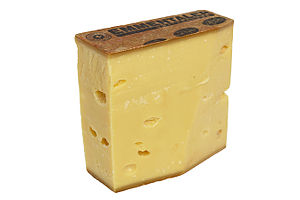Emmental cheese
| Emmental | |
|---|---|
 | |
| Other names | Emmenthal, Emmentaler, Emmenthaler[1] |
| Country of origin | Switzerland |
| Region, town | Emmental, canton of Bern |
| Source of milk | Cow |
| Pasteurized | Not traditionally |
| Texture | Medium-hard |
| Aging time | 2–18 months depending on variety |
| Certification | Some varieties |
Emmental, Emmentaler, or Emmenthal is a yellow, medium-hard cheese that originated in the area around Emmental, in the canton of Bern in Switzerland. It is classified as a Swiss-type or Alpine cheese.
Emmental was first mentioned in written records in 1293, but first called by its present name in 1542.[2][3] It has a savory but mild taste. While "Emmentaler" is registered as a geographical indication in Switzerland, a limited number of countries recognize the term as a geographical indication: similar cheeses of other origins, especially from France (as Emmental),[4] the Netherlands,[5] Bavaria, and Finland, are widely available and sold by that name. In some parts of the world, the names "Emmentaler" and "Swiss cheese" are used interchangeably for Emmental-style cheese.
Production
Three types of bacteria are needed to prepare Emmental: Streptococcus thermophilus, Lactobacillus helveticus, and Propionibacterium freudenreichii. Historically, the holes were a sign of imperfection, and until modern times, cheese makers would try to avoid them.[6] Nowadays, however, eye formation is valued as a sign of maturation and quality and acoustic analysis has been developed for this purpose.[7] Emmental cheese is usually consumed cold, as chunks or slices,[8] and is also used in a variety of dishes, particularly in gratins, and fondue, in which it is mixed with Gruyère.
Protected varieties and nomenclature
Several varieties of Emmental are registered as geographical indications, including:
Switzerland
- Emmentaler AOC was registered in 2000 as an appellation d'origine contrôlée (AOC).[9][10][11] In 2013, it was replaced by the appellation d'origine protégée (AOP) certification. This original Emmental is produced in small rural dairies with raw cow's milk, adding only natural ingredients (water, salt, natural starter cultures and rennet); preservatives or ingredients from genetically modified organisms are not allowed. The cheese is produced in a round shape with a natural rind, and aged in traditional cellars for a minimum of four months. This Emmental has three age profiles: classic, aged at least four months; réserve, aged at least eight months; and Premier Cru, aged at least fourteen months.
As a geographical indication, Emmentaler is recognized in Czech Republic, France, Georgia, Germany, Hungary, Jamaica, Portugal, Russia, Slovakia and Spain.[12]
Outside Switzerland Three cheeses containing the word Emmental are protected under EU law:
- Allgäuer Emmentaler, from Bavaria, Germany, has PDO status[13]
- Emmental de Savoie, from Savoie, France, has PGI status[14]
- Emmental français est-central from Franche-Comté, France, also has PGI status[15]
In many parts of the English-speaking world the terms "Emmentaler" and "Swiss cheese" are both used to refer to any cheese of the Emmental type, whether produced in Switzerland or elsewhere. The United States Department of Agriculture, for example, uses the terms 'Swiss cheese' and 'Emmentaler cheese' interchangeably.[16][17]
Emmental-style cheeses
Emmental cheese is very widely imitated around the world, often just called "Swiss cheese". Specific European types include:
- Grevé from Sweden
- Jarlsberg cheese from Norway
- Maasdam cheese from the Netherlands, with Leerdammer one variety
See also
References
- ^ "Emmenthal definition and meaning". Collins English Dictionary. Retrieved 2020-11-08.
- ^ Dominik Sauerländer, Anne-Marie Dubler: Käse in German, French and Italian in the online Historical Dictionary of Switzerland, 5 February 2018.
- ^ Ehlers, S.; Hurt, J. (2008). The Complete Idiot's Guide to Cheeses of the World. Complete Idiot's Guide to. Alpha Books. p. 76. ISBN 978-1-59257-714-9. Retrieved May 19, 2016.
- ^ "Emmentaler". Cheese of France. Retrieved 25 October 2020.
- ^ "Emmentaler". Retrieved 25 October 2020.
- ^ Scientific American Cheese Story August 2010 Pg 33
- ^ González, Mariana; Budelli, Eliana; Pérez, Nicolás; Lema, Patricia (27 November 2019). "Acoustic techniques to detect eye formation during ripening of Emmental type cheese". Innovative Food Science & Emerging Technologies. 59: 102270. doi:10.1016/j.ifset.2019.102270. S2CID 213732802.
- ^ "Emmentaler AOP", Switzerland Cheese Marketing. Retrieved 26 October 2020.
- ^ "Emmentaler: AOC-Gütesiegel". Archived from the original on December 11, 2010. Retrieved December 11, 2009.
- ^ Government of Switzerland. "Appellations d'origine et indications géographiques". Retrieved 1 October 2021.
- ^ "AOC-Label für den Käse mit den grössen Löchern". Swiss Info. 13 September 2004. Retrieved 11 December 2009.
- ^ "Emmentaler". Origin GI. 3 September 2021. Retrieved 1 October 2021.
- ^ "DOOR". Ec.europa.eu. 1997-01-24. Retrieved 2016-05-14.
- ^ "DOOR". Ec.europa.eu. 1996-06-21. Retrieved 2016-05-14.
- ^ "DOOR". Ec.europa.eu. Retrieved 2016-05-14.
- ^ Swiss Cheese, Emmentaler Cheese Grades and Standards, U.S. Department of Agriculture, accessed March 25, 2020
- ^ How to Buy Cheese, U.S. Department of Agriculture (1971), p. 15
External links
- Emmentaler in the online Culinary Heritage of Switzerland database.
- Cook's Thesaurus: Semi-Firm Cheeses
